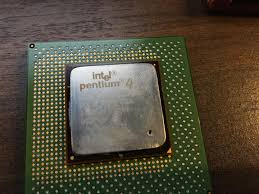Table of Contents
Pentium 4 650: Vogon Poetry in Silicon:

The Pentium 4 650 is an artifact of a bygone era when Intel pushed the boundaries of clock speed to extremes. Released in 2005, it was based on Intel’s Prescott core, an ambitious iteration of the NetBurst microarchitecture. This processor was designed for users who demanded high performance for single-threaded tasks, multimedia, and gaming.
Yet, its quirks, such as excessive heat generation and power consumption, made it as memorable for its flaws as its strengths.As we delve into the architecture, innovations, and legacy of the Pentium 4 650, we discover the triumphs and lessons that shaped the evolution of modern processors.
The Architecture of Awesomeness (and Occasional Frustration):
The Pentium 4 650 was built on Intel’s 90nm process and boasted a 3.4 GHz clock speed, 2 MB L2 cache, and an 800 MHz front-side bus. This architecture promised significant performance gains for applications reliant on raw processing power.
At the core of this CPU was Intel’s NetBurst microarchitecture, characterized by:
- Long Instruction Pipeline:
A 31-stage pipeline enabled high clock speeds but introduced latency penalties for branch mispredictions, making it less efficient for certain workloads.
- Enhanced Cache:
The larger 2 MB L2 cache improved data retrieval times, reducing memory access bottlenecks.
- 800 MHz Front-Side Bus (FSB):
This high-speed FSB allowed faster communication between the CPU and system memory, crucial for handling demanding tasks.
However, the architectural focus on maximizing clock speeds came at the expense of power efficiency and thermal performance. The Pentium 4 650 required robust cooling solutions and often pushed system power supplies to their limits.
READ MORE: Chagaras – Elevate your wedding!
The Hyper-Threading Advantage (and Its Shadows):
1. Intel® Pentium® 4 Processor 650 Supporting HT Technology:
One of the standout features of the Pentium 4 650 was Hyper-Threading (HT) technology. This feature allowed a single physical processor core to appear as two logical cores, enabling the CPU to handle two threads simultaneously.
Hyper-Threading was particularly beneficial for:
- Multitasking:
Running multiple applications simultaneously without significant performance degradation.
- Workload Optimization:
Enhancing performance in multi-threaded applications like video encoding, rendering, and scientific simulations.
2. What Is Hyper-Threading? – Intel:
Hyper-Threading works by sharing the CPU’s resources between two threads, ensuring idle execution units are utilized. However, its effectiveness depended on software optimization. For tasks that weren’t multi-threaded, the performance improvement was marginal, and in some cases, it even introduced minor inefficiencies.
The Heat is On:

The Pentium 4 650 became infamous for its thermal challenges. Dubbed “PresHot” by enthusiasts, its Prescott core generated significant heat under load.
Key Factors Behind the Heat Issues:
- High Clock Speed:
The pursuit of GHz numbers led to higher power consumption and heat generation.
- Inefficient Thermal Design:
The architecture’s design didn’t prioritize thermal efficiency, making it dependent on robust cooling solutions.
Cooling Solutions:
To manage the heat, users often turned to:
- High-performance air coolers with large heatsinks and high-speed fans.
- Liquid cooling systems for better thermal management and quieter operation.
- Exotic cooling methods, such as phase-change cooling, used by extreme overclockers.
The Memory Wall:
Despite its high performance, the Pentium 4 650 frequently encountered the “memory wall.” This phenomenon occurs when the CPU’s speed outpaces the memory’s ability to supply data, leading to bottlenecks.
DDR2 Memory Transition:
The Pentium 4 650 supported DDR2 memory, which provided higher bandwidth and lower power consumption than DDR. However, the technology was still in its early stages, and latencies remained a concern, limiting the CPU’s potential in memory-intensive applications.
READ MORE: Make Him Jealous Spencer Bradley – You May Interested!
A Legacy of Performance (and a Touch of the Absurd):
The Pentium 4 650 was both a technological marvel and a cautionary tale. It marked the peak of Intel’s clock-speed-driven approach but also revealed the limits of that philosophy.
Key Contributions to CPU Evolution:
- Hyper-Threading:
Laid the groundwork for modern multi-threading technologies.
- Thermal Management Awareness:
Highlighted the importance of efficiency and thermal design in CPUs.
- Consumer Insights:
Shifted the industry’s focus from clock speed to overall performance and power efficiency.
The Price of Performance:
At launch, the Pentium 4 650 was priced at a premium, appealing to power users and enthusiasts. While it delivered cutting-edge performance for its time, the cost-to-performance ratio raised eyebrows, especially when compared to AMD’s Athlon 64 processors, which offered better efficiency and cooler operation.
The Pursuit of Perfection (and the Inevitable Flaws):
Intel’s relentless drive for performance resulted in a processor that was both innovative and flawed. The Pentium 4 650’s challenges underscored the importance of balancing raw performance with efficiency, power consumption, and thermal design. These lessons shaped the future of processor design, leading to more balanced architectures like Intel’s Core series.
FAQ:
1. What were the main applications of the Pentium 4 650?
The Pentium 4 650 excelled in tasks requiring high single-threaded performance, such as office productivity, gaming, multimedia editing, and web browsing. Its Hyper-Threading technology also made it suitable for multi-threaded workloads like video encoding and rendering.
2. Did the Pentium 4 650 have any lasting impact on CPU design?
Absolutely. It showcased the limits of a clock-speed-driven approach and highlighted the need for efficient, balanced designs. Lessons learned from the Pentium 4 era influenced Intel’s shift to the more efficient Core microarchitecture.
3. Is it still possible to find and use a Pentium 4 650 today?
Yes, though it’s mostly of interest to retro tech enthusiasts or collectors. The Pentium 4 650 can be found in second-hand markets, but its practical use is limited by outdated performance and software compatibility.
Conclusion:
The Pentium 4 650 remains a fascinating piece of tech history, embodying the highs and lows of Intel’s quest for dominance in the CPU market. Its strengths in single-threaded performance and Hyper-Threading technology were matched by its struggles with heat and efficiency. Today, it stands as a reminder of the ambitious strides made in computing and the importance of learning from technological missteps.
RELATED POST:
- READ MORE: Cto New Canaan – All You Need To Know!
- READ MORE: Deț – Start Your Balance Journey Now!
- READ MORE: Mymadeinke – Explore Unique Creations Today!



